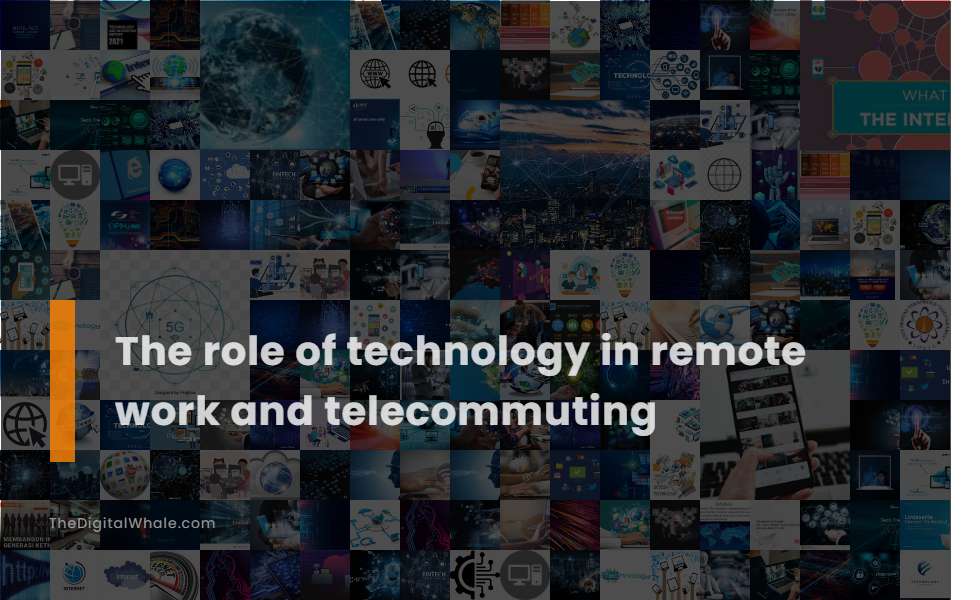The Role of Technology In Remote Work and Telecommuting
What is the difference between telecommuting, telework, and remote working? What is telecommuting and remote work? Let's find out more about The Role of Technology In Remote Work and Telecommuting.

Advanced Technology for Remote Work: Enables employees to complete tasks online from any location.
In 2024, advanced technology is set to revolutionize remote work by integrating AR and VR for immersive collaboration, creating hyper-personalized work environments through AI and machine learning, and adopting cloud-native work tools alongside enhanced cybersecurity solutions. These innovations will enable employees to customize their workspaces and harness unified communication platforms, project management tools, and collaboration software, resulting in increased productivity, efficiency, and cost savings. Essential technologies such as video conferencing platforms like Zoom and Google Meet, along with screen-sharing capabilities and breakout rooms, are pivotal in supporting seamless collaboration from any location. Explore more about this transformation on The Future of Work.
Cloud Computing: Allows for the storage and management of data, reducing the need for physical office space.
Cloud computing plays a crucial role in remote work by enabling the storage and management of data centrally, allowing remote workers to access files, applications, and data from anywhere with an internet connection, and facilitating seamless collaboration, scalability, and cost-efficiency while enhancing data security and productivity. This technology reduces the need for physical office space and supports flexible, secure, and efficient Remote Working Environments.
Virtual Communication Tools: Facilitates communication and collaboration among remote workers.
Virtual communication tools like Zoom, Slack, Microsoft Teams, and Connecteam play a crucial role in remote work by facilitating various forms of communication, including video conferencing, instant messaging, and file sharing, thereby enhancing collaboration and productivity among remote teams. These tools, such as Nextiva, Skype, and Google Meet, enable remote workers to engage in HD video and audio conferences, share files, and manage tasks, ensuring seamless communication and collaboration across different locations and devices. Technologies like Zoom, Microsoft Teams, and Google Hangouts are essential for remote work, offering features such as video conferencing, real-time messaging, and file sharing, which help in maintaining productivity and effective collaboration among remote employees.
Increased Productivity: Technology helps manage remote environments to enhance employee productivity.
Technology plays a crucial role in enhancing labor productivity within remote work environments by offering a suite of tools that facilitate effective communication, collaboration, and workflow management. This not only boosts productivity but also accelerates project completion speeds. The integration of various technologies, including collaborative software, project management applications, and communication platforms, empowers remote employees to increase their productivity, foster real-time collaboration, and improve time management. As a result, these advancements lead to higher efficiency and performance in remote work settings. To delve deeper into how technology can enhance labor productivity, visit the insightful article on Psico-Smart.
Access to Global Talent: Enables employers to hire the best talent regardless of geographic location.
Technological advancements in remote work have significantly transformed international talent acquisition, allowing companies to extend their reach beyond geographical limitations and access a global pool of highly skilled individuals. By utilizing cutting-edge remote work technologies such as high-speed internet, cloud computing, and sophisticated collaboration tools, employers can now recruit top talent from virtually anywhere, which enhances both team diversity and innovation. As noted in the Vorecol Blog, this revolution in how organizations acquire talent not only breaks down physical barriers but also ensures that companies can hire the best talent globally by leveraging essential tools and implementing robust cybersecurity measures.
Related:
How can a business leveraging teleconference and collaboration tools improve performance? What are some dynamic technologies for small businesses to utilize to gain a competitive advantage? Let's find out more about How Businesses Can Use Technology To Create A Competitive Advantage.
Reduced Operational Costs: Technology helps in downsizing office space and reducing overhead costs.
The advent of technology in remote work has significantly impacted operational costs by reducing expenses on real estate, utilities, cleaning services, and office equipment. As companies embrace this new mode of operation, some reports highlight substantial savings, with estimates as high as $10,000 per employee annually. This shift is further accentuated by businesses Downsizing Office Spaces, which is often facilitated through cloud-based solutions like VoIP. By optimizing their physical presence, companies not only cut down on rental and maintenance costs but also enhance workplace efficiency and employee experience. Notably, businesses have reported saving up to $2.6 million annually by closing underutilized floors, underscoring the profound financial benefits of optimizing office space in the age of remote work.
Enhanced Sustainability: Cuts commuting emissions and optimizes space use, reducing the company's carbon footprint.
The integration of remote work technologies significantly enhances sustainability by reducing commuting emissions and optimizing space use, thereby lowering the company's carbon footprint and promoting a greener work environment through tools like HR Management Systems that streamline workflows and reduce energy consumption. According to studies, remote work can cut hundreds of millions of tons of carbon emissions from car travel by reducing the need for daily commutes, although it also impacts public transit revenues. This highlights a complex but overall positive effect on sustainability, showcasing the importance of innovative solutions. For more detailed insights on this transformation, visit the Integration Of Remote Work Technologies article.
Better Work-Life Balance: Technology supports flexible scheduling, improving employees' work-life balance.
Technology supports remote work by offering flexibility in scheduling, allowing employees to work during their most productive hours and manage their personal and professional responsibilities more effectively, leading to a better work-life balance. This is facilitated by tools such as remote communications platforms and project management applications, which enable workers to strategically schedule their activities. According to App Academy, these tools help individuals attend to personal tasks and maintain a healthier work-life balance, showcasing the advantages of adopting technology in the modern workplace.
Improved Employee Satisfaction: Technology enhances mental and physical health, and job satisfaction among remote workers.
Technology in remote work enhances employee satisfaction by offering flexibility, reducing commute stress, and improving work-life balance, leading to increased productivity and happiness, with 84% of remote workers feeling happier and 77% better managing mental health issues. Effective use of digital communication tools, project management software, and clear communication channels also foster a sense of belonging and trust, contributing to higher job satisfaction and well-being. For more insights, you can read the full report on Remote Work Effectiveness for Tech Companies.
Security and Data Management: Allows for secure handling of sensitive documents through cloud servers and other digital solutions.
Technology in remote work significantly enhances security and data management by implementing measures such as multi-factor authentication, virtual private networks (VPNs), and the Zero Trust security model. These strategies ensure the secure handling of sensitive documents and protect against data breaches and unauthorized access. Additionally, secure document management systems, including FileCloud, offer solutions like encrypted file transfer, granular access controls, and version tracking. Such systems enable organizations to securely manage, organize, and share sensitive documents while maintaining compliance with data protection regulations. Addressing security for remote work also involves tackling risks linked to unsecured Wi-Fi networks and ensuring compliance with standards like HIPAA and GDPR. These issues can be addressed through robust security policies, employee education, and advanced encryption methods. For example, Smartvault exemplifies how document management software ensures secure handling through encryption during transit and at rest, alongside automated organization and controlled access through granular permissions. Such comprehensive strategies are vital for enhancing overall data security and compliance in remote work environments.
Related:
Is a mobile phone essential for sales and marketing? What is the value of a mobile app used by employees to track their work progress? Let's find out more about Using Mobile Devices and Apps at Work - What'S Appropriate and What Isn'T?.
